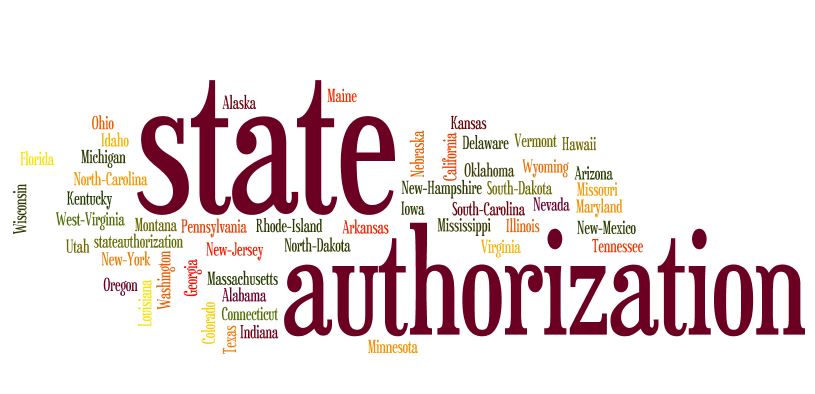Some new federal regulations may be coming your way and we need to make our voice heard. We need your help in addressing concerns in four areas: ensuring equity for financial aid, student identity, accessibility, and state authorization of distance education.
The Higher Education Act
This year we celebrate the 50th anniversary of the Higher Education Act of 1965. It’s long title declares it to be: “An Act to strengthen the educational resources of our colleges and universities and to provide financial assistance for students in post-secondary and higher education.”
The 1965 version of the Act was 58 pages.
The Act was the beginning of Congress’s attempt to codify the relationships that the federal government has with higher education. Over the years, the rules for institutions to remain eligible to offer federal financial aid have grown. Congress uses it as a hammer to impose additional requirements on colleges. Although the Act is supposed to be “reauthorized” every five years, the last time such action was taken was 2008.
 The 2008 version weighed in at 432 pages. Seven years later, the Department has yet to implement all of the provisions growing out of the last Act. Life is more complicated, I guess.
The 2008 version weighed in at 432 pages. Seven years later, the Department has yet to implement all of the provisions growing out of the last Act. Life is more complicated, I guess.
We Need Your Help
Congress is finally moving forward on the next reauthorization. Hearings are being held and we think that they may actually have some success in taking real action.
We’ve identified four issues (regarding distance education and technology-mediated learning) on which we would like to see (or not see) action. There are more, but these items rose to the top in several recent discussions with Steering Committee representatives, advisors, and WCET members.
Below is a brief outline of the issues. We need your feedback and invite you to let us know if there are others that should be added to the list.
The Four Issues
1) Ensuring Equity
Think of a college student. Did you think of a young person between 18 and 22 who lives on campus? Increasingly, that is not the norm. Unfortunately, policymakers are often unable to overcome the fixation on the “traditional” student.
Context
Thank you to Christina Sedney of the Adult College Completion Network for unearthing the following statistics from the CLASP brief “Yesterday’s Non-Traditional Student is Today’s Traditional Student” (Updated January 14, 2015):
- Four in 10 undergraduate students are 25 years or older, a 4 percentage point increase from 2008[i].
- From 2012 to 2022, the non-traditionally aged student enrollment in college is projected to grow more than twice as fast as for traditional age students (8.7% and 21.7%, respectively)[ii].
- 51% of undergraduate students are classified as independent (meaning: 24 years or older, married, responsible for legal dependents other than a spouse, orphans or wards of the court [or were wards of the court until age 18], veterans of the U.S. armed services, or homeless or at risk of homelessness)[iii].
Recommendations
What we would like to see:
1.1 Financial aid rules should treat learners equally as much as possible, regardless of mode of instruction, full-time/part-time status, month of the year, or other irrelevant characteristics that disadvantage the non-traditional learner. Specifically, don’t limit aid just because a student is taking distance courses.
1.2 Return to the year-round Pell Grant.
1.3 Develop reasonable accommodations for educational innovations, such as competency-based education, adaptive learning, prior learning assessment, alternative providers, and innovations of which we’ve not yet dreamed.
2) Student Identity / Fraud / Academic Integrity
We’re all against fraud, which is the act of criminals using false identities to steal financial aid funds. This is a criminal activity and robs honest students of funds that could be available to them.
We’re all for academic integrity, which is keeping students from cheating on tests, papers, and assessments. While not a criminal activity, it devalues the work of honest students.
Context
In February 2014, the Department of Education’s Office of Inspector General (OIG) released a scathing report regarding the Department’s and colleges’ lack of efforts in curtailing financial aid fraud. While the report makes some excellent recommendations, there are places in which they confuse fraud and academic integrity. Solutions for one may not work or may be too onerous for the other. The Department was supposed to issue a response by the end of Spring of 2014, but it has yet to be published.
Recommendations
What we would like to see (based on the recommendations from the OIG report). Some of these recommendations might best be handled outside of HEA, but are added for completeness sake. See my earlier blog post for a more complete discussion:
2.1 Institutions should verify student identify at enrollment. This should apply to all students, not just distance education students.
2.2 Reject the OIG’s recommendation to have independent auditors review student identify verification systems.
2.3 Require more frequent disbursements of aid. This should apply to all student, not just distance education students.
2.4 Better define first and last day of attendance for students who withdraw without officially notifying the institution. Simplify current, poorly defined rules, that greatly disadvantage and burden colleges offering distance education.
2.5 “Cost of attendance” calculations for students should reflect true costs. We reject earlier attempts to arbitrarily strip distance education students of the ability to count living expenses or computing costs as part of their “cost of attendance.”
2.6 The OIGs report does not address what may be the best deterrent to problems regarding student identity, that is education of front-line employees, such as faculty and student services staff. If they know what behaviors to monitor, they will catch unwanted activities much quicker than most of the other recommendations combined.
3) Accessibility of Educational Technologies
We’re all for equal access to educational technologies for those with disabilities.
Context
Jarret Cummings from EDUCAUSE updated us on the TEACH ACT earlier this year:
“The National Federation of the Blind (NFB) and the Association of American Publishers (AAP) worked with members of Congress last year to introduce the Technology, Equality and Accessibility in College and Higher Education Act (TEACH Act). The bill proposed to foster the development of voluntary guidelines for ‘electronic instructional materials and related technologies.’ Many higher education associations support this goal, believing that voluntary guidelines could help colleges and universities continue to improve in meeting the learning needs of students with disabilities. However, they have concerns that the bill as written would unintentionally hamper the use of technology to advance learning by all students, including those with disabilities.”
I met with Jarret recently. He continues to work with the NFB and others to develop new language that would be more universally acceptable.
Recommendations
What we would like to see:
3.1 Support for the agreement that is currently being forged by EDUCAUSE, NFB, and others. We’ll receive final judgment until we see the final language, but we have great trust in Jarret’s leadership in finding an equitable solution.
4) State Authorization of Distance Education
We’re all for the protection of students as consumers of distance education. In creating regulations, weigh the competing interests of state oversight, federal oversight for financial purposes, and both the responsibility and burden placed on institutions. On the latter point, institutions often highlight the burden while forgetting their responsibilities.
Context
Yes, I’m very much invested in this one. I was on the Department of Education’s Negotiated Rulemaking team last year, which failed to come to consensus on new language for state authorization for distance education. The Department’s negotiators insisted on keeping a provision that would have disallowed states from issuing exemptions to any institution. We continue to object to that provision as it provided no real protection for students, but would have added considerably more work and confusion to the authorization process.
The ball is currently in the Department of Education’s court to issue regulations for public comment. They say that they are still on “pause” with no timeline for issuing the regulation. If it is not issued in the next few weeks, it is unlikely that we will see a new federal regulation this year.
Recommendations
What we would like to see (much of this is taken from the recommendations made jointly by OLC, UPCEA, and WCET last year. While there are more recommendations, I’m highlighting these three in this blog post):
4.1 Return to the 2010 Language. We recognize the affirmation by the U.S. Court of Appeals that the Department can use state authorization as a criterion for offering federal financial aid. As a basis for any future regulation, the Department should return to the state authorization language released in October 2010 that required an institution to “meet any State requirements for it to be legally offering postsecondary distance or correspondence education in that State. An institution must be able to document to the Secretary the State’s approval upon request.”
4.2 Recognize Reciprocity. We recommend that the Department continue to recognize reciprocity as a means to authorization. Through reciprocity, one state recognizes the authorization actions of another state participating in a reciprocal agreement. SARA’s progress to 24 states (as of this post) in less than 18 months indicates the success of this approach.
4.3 Exempt Military, Military Families, and the Veterans Administration Facilities. The Department should retain the proposed provision that exempts active military and their families. They should also work with states to update their state regulations to reflect this exemption.
You Turn – We’d Like Your Feedback
This is obviously an outline of a set of proposals. How would you improve them? What would you add? What other issues should be addressed? Would love hearing from you.

Russ
Russell Poulin
Director, Policy & Analysis
WCET – WICHE Cooperative for Educational Technologies
rpoulin@wiche.edu
If you like our work, join WCET!
Photo credit: Stephen Melkisethian
[i] Source: Author’s calculations using NCES PowerStats, Source: “2011-12 National Postsecondary Student Aid Study (NPSAS:12),” U.S. Department of Education, National Center for Education Statistics, calculated 12/09/2014.
[ii] Source: http://nces.ed.gov/pubs2014/2014051.pdf, Author’s calculations using Table 21. Actual and projected numbers for total enrollment in all postsecondary degree-granting institutions, by age group, sex, and attendance status: Fall 1997 through fall 2022, Projections of Education Statistics to 2022, February 2014.
[iii] Source: Author’s calculations using NCES PowerStats, Source: “2011-12 National Postsecondary Student Aid Study (NPSAS: 12),” U.S. Department of Education, National Center for Education Statistics, calculated 12/09/2014.




6 replies on “Four Recommendations for the Higher Ed Act Reauthorization”
[…] Four Recommendations for the Higher Education Act Reauthorization by Russ Poulin […]
This comment is directed to the recommendations on identify fraud reduction. I’m not sure the WCET recommendations take into account the realities of enrollment or the availability of technology to solve. The recommendation essentially says nothing should change and we should rely on enrollment as the single point of identify verification. This is not only dated but fails to consider many enrollment processes are done electronically, web based or some other method not using a face to face process. Not only that, this is only one point of verification. Fraud happens in the registration process as well, if you get past the one gate this recommendation allows you to continue. There is technology used as good business practice to authenticate identify, it should become good enrollment practice. Identity fraud is something accreditation is not trained or equipped to either evaluate or review. Using independent audits such as software license audits (which are being used at many schools now) is not only an effective method for evaluating fraud reduction it may even provide some legal protection should the fraud move to more security violations. I’m not sure this recommendation address what can be done or good practice in reducing identify fraud. Rather than focus on not doing anything about fraud (this seems to be the recommendation relying on one point of a process: enrollment) we should be accepting the OIG recommendations as most realize a login and password are not the most effective means.
I think recommendation 4.1 may need further clarification. Since state authorization deals with more than distance education, going back to the wording from 2010 does not address the other triggers for state authorization like internships, recruiting, advertising, etc. I suggest wording something like this:
“meet any state authorization requirements as determined by regulations in that state.”
Great summary and on the whole agree with the recommendations.
On Identity Fraud Reduction, I think I understand the recommendation to to reject the OIG item concerning an independent auditor to review student identification verification systems. However, are there existing criteria in place that define what is an acceptable system? If not, shouldn’t there be a recommendation to establish some standards for these id verification systems? As schools implement these, what criteria can be used both by the school and externally to insure there is a valid system in place. As schools may want to purchase same from a vendor what criteria are there to know the vendor is providing an acceptable solution? What defines an acceptable student identification verification system? This doesn’t have to be one size fits all but may be a matrix of elements and definitions for which elements need to be in place for a valid system. Much of this can be taken from existing standards for authentication from places like NIST.
I’m with Chuck on this: I argue heavily for verifying student identity at time of enrollment because the identity of the student to receive academic credit should be established before the student starts receiving instruction regardless if the student is face-to-face or online. It should likewise be true that the student conducting business with the institution should be the student who enrolled. Therefore identity should be verified at each transaction with the institution including taking roll in a face-to-face class or loging into an LMS as well as accepting financial aid or participating in degree audits etc. All of this serves to make sure the student conducting any transaction with the institution is the student who enrolled. It seems to me this method addresses the problems of student integrity and fraud as well as addressing information technology computer/network security concerns.
I recommend that all college students in USA be required to take national standardized tests once a year from recognized providers covering the major field and the several core subjects much as is done for public schools and in foreign colleges. Student aid grants and loans including amounts and interest rates should be provided on a sliding scale depending on performance in the tests, combined with other factors such as choice of majors, leadership activities, and conduct. Accreditation of colleges should be scaled to reflect the percent of students performing at poor, good, or excellent levels of standardized tests. The best colleges will get the best support, and the public will get better value for the money.
In my own situation, presently retired for the third time in old age, I have 5 degrees from traditional colleges, and two other degrees from innovative programs, all earned years ago when cost was a lot less. Now I see enormous debt accumulating for younger students for a single degree program, to the outrageous extent of endangering the national economy.
Traditionally a lot of students I saw, maybe half of the class failed to gain competency in the major field, but largely attended college for social life. Traditional students banded together demanding easier classes, with the knowledge that the professors could not afford to fail a whole group, while serious students were harassed to lower the performance standards. That will probably continue but should not be done at public expense.
Public policy should be reformed, and performance based funding of education is the best way to start.